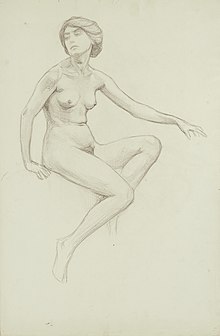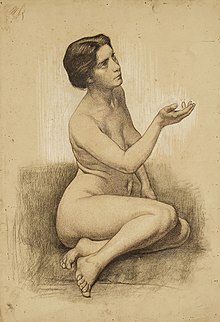Sigmund Lipinsky
Sigmund Lipinsky (born June 29, 1873 in Graudenz , † February 17, 1940 in Rome ) was a German painter and graphic artist .
life and work
Sigmund Lipinsky grew up in Graudenz, West Prussia, at Herrenstrasse 24 (today ul. Pańska 15, Grudziądz, Poland ). His father, Isidore Lipinski (Izydor Lipiński), was a businessman and one of the younger sons of the Polish violinist and composer Karol Józef Lipiński . The mother Wilhelmina was a granddaughter of the opera composer Giacomo Meyerbeer . In 1887 the family moved to Berlin , where Sigmund Lipinsky graduated from high school in 1888 with a high school diploma. Until 1890 he attended a preparatory class for art studies. After passing the entrance examination at the Royal Academy of Arts , he began studying in November 1890 under the direction of Woldemar Friedrich , Josef Scheurenberg and Anton von Werner , whose master class he became.
In 1899 Lipinsky went on a trip to the Netherlands, where he supplemented his knowledge of graphic techniques. In the same year he won the competition for the design of frescoes for the castle of the von Moltke family in Kreisau in Silesia and received the great state prize with a Rome grant . From 1900 to 1902 Anton von Werner won him over to work on the designs (cardboard boxes) for the design of the dome of the Berlin Cathedral . During this time, living at Knesebeckstrasse No. 4 in Charlottenburg , Lipinsky married the violinist Paula Klein, a daughter Anneliese was born, but the marriage was short-lived.
In 1902, Lipinsky moved from Berlin to Rome in 1902 and initially settled in the Villa Strohl-Fern . As an artist of Jewish origin, he was able to finance an extension of his stay through the award of the Michael Beer Foundation in 1904 and decided to stay in Rome in 1905, joined the German Artists' Association there , and married the artistically talented Chilean a second time German origin Elinita Kümpel. He had three children with her. Like other German Romans before him, he spent the summers in the wild nature of Terracina . Encouraged by Otto Greiner , with whom he was friends, and Max Klinger , to whose circle Tyra Kleen belonged in her Roman times, Lipinsky looked for motifs in mythology and turned to symbolism . He painted in watercolor, oil and drew naturalistic nudes. "[...] the naturalism of his nudes can hardly be surpassed, and one can already say that since the death of Greiner, who was close to Lipinsky, only a few have been allowed to stand next to him as nude artists." From 1911 he devoted himself more to etching and that Engraving , designed ornate letterheads and a large number of bookplates , and founded the Sigmund Lipinsky Academy , a painting and drawing school . This was in the legendary artist street Via Margutta No. 33 near the Spanish Steps .
The stay in Rome was interrupted by the First World War and Lipinsky, like all German artists, was forced to leave Italy. The Lipinsky family moved to Munich at Kaulbachstrasse 34a. Here he came into contact with the artists of the Munich Neue Secession , the Neue Künstlervereinigung and the Berlin Neue Secession . In 1919 the family returned to Rome and Lipinsky initially gave drawing lessons at the British Academy of Arts . The summers he alternated between the coast of Terracina and Capri . He had numerous classes in his own academy for painting, graphics and drawing, and at the same time devoted himself to the anatomy of the body. In 1931 he published the “Manuale Anatomico. Per la Studio Artistico del corpo umano ”, a work with 25 plates and appendices of anatomical names.
The art collector Herbert Wollmann (1870–1937), from 1906 to 1935 chancellor at the (first Prussian, then) German embassy to the Holy See, was a supporter and friend of the Lipinsky family. With the Gruppo Romano Incisori Artisti - GRIA (group of Roman art graphic artists ), which he co-founded, Lipinsky was represented at numerous exhibitions in Italy, Vienna and Berlin. The graphics had become gradually be dominant subject. He rarely resorted to painting, including a few portraits, genre compositions, including a number of watercolors depicting the daily life of the Papal Swiss Guard, and sketches of landscapes.
In 1939 he went to Switzerland because of his deteriorating health. Sigmund Lipinsky died in Rome in February 1940, where he was buried in the Campo Verano cemetery. His works are in public collections in Rome, Florence, Monaco, London, Berlin, New York, Los Angeles, Warsaw and Graudenz.
family
Sigmund Lipinsky married Paula, née Klein (born July 16, 1876 in Königsberg) around 1900, a daughter was born. In his second marriage he was married to Elinita, born Kümpel (born November 29, 1875 in Valparaíso, † November 23, 1957 in Rome). The children from this marriage grew up in the vital and cosmopolitan atmosphere of the German community in Rome, and also devoted themselves to art.
- Anneliese Lipinsky (born April 21, 1900 in Charlottenburg, † December 10, 1966 in Rome)
- Angelo Lipinsky (born April 26, 1904 in Rome; † March 31, 1986 there) became an art historian.
- Lino Sigismondo Lipinsky (born January 14, 1908 in Rome, † August 11, 1988 in Katonah, New York) was a well-known graphic artist, painter and curator. At the age of 17 he already received the honor of becoming a full member of the GRIA (Gruppo Romano Incisori Artisti). In 1939 he immigrated to the USA.
- Eva Lipinsky-Episcopo (born April 4, 1911 in Rome; † June 16, 1988) and after her father's death took over the management of the art school, which existed until 1978. She married the doctor Ubaldo Episcopo, who bought the house in 1980 at 33 Via Margutta (now a hotel).
Work (selection)
- The source , 1900
- Pandora , 1911
- Mer calme (calm of the sea), 1911/1912
- Le Parche (The Parzen), etching, 1914
- The Italian , 1919
- Lonely Garden , 1919
- Inter arma , 1920
- Il Concilio degli Dei , 1923
- Latin Beach , 1928
- Portrait of Raoul Heinrich Francé , etching
- Bookplate: Hermann Wenz
- Bookplate: Vicente Bosch
literature
- Sigmund Lipinsky, Manuale anatomico, Libreria Herder, Roma MCMXXXI - IX (1931)
- Angelo Lipinsky: Sigmund Lipinsky and his graphic work , Maso Finiguerra AV, nn.1-2, 1940
- Emanuele Bardazzi, Donatella Cingottini: Il sogno mediterraneo, Artisti tedeschi tra '800 e' 900 , Firenze 1997
- Francesco Parisi: Sogni e Visioni. Grafica Europea tra Simbolismo e Secessione , Rignano Flaminio, 2009
- Emanuele Bardazzi: Sigmund Lipinsky, Dario Wolf & altri maestri dell'incisione simbolista , Edizioni Officine Vereia, Rignano Flaminio, 2012
- Artisti a Villa Strohl-Fern. Luogo d'arte e di incontri a Roma tra il 1880 e il 1956 , Gangemi, 2012, ISBN 978-88-492-2337-8
- Richard Braungart: Siegmund Lipinsky , The Art for All. XXXVIII. June 1923, pp. 249-258 digitized
Web links
- Jadwiga Drozdowska: Biuletyn: Sigmund Lipinsky (1873-1940) (Polish) , on kmdg.grudziadz.pl, newsletter of September 4, 2004, accessed on July 14, 2016
- Sigmund Lipinsky , on Artnet, accessed July 14, 2016
Individual evidence
- ^ Lipinsky, Sigmund, Genre and Histor. Painter, Charlottenb., Knesebeckstr. 4 , in address book for Berlin and its suburbs, 1900
- ↑ German ex-libris and other small graphics of the present , on kunstmuseum-hamburg.de of May 11, 2015, from the book by Richard Braungart: German ex-libris and other small graphics of the present , 1922
- ↑ Digital archive collection: Lipinsky zd Klein Paula , on szukajwarchiwach.pl (Akta Miasta Poznania - Kartoteka ewidencji ludności, 1870-1931)
- ↑ Lanfranco Mazzotti: Angelo Lipinsky , Biography (Italian) , in Dizionario Biografico degli Italiani, online
- ^ Lino S. Lipinsky de Orlov, also: Lino Sigismondo Lipinsky de Orlov, Lino S. Lipinsky, Lino Sigismund Lipinsky , on Smithsonian American Art Museum, Washington
- ↑ History: Episcopo Lipinsky ( Memento of the original from July 14, 2016 in the Internet Archive ) Info: The archive link was inserted automatically and has not yet been checked. Please check the original and archive link according to the instructions and then remove this notice.
- ^ Etching portrait RH Francé , Art for All. XXXVIII. June 1923, p. 250
- ^ Bookplate Hermann Wenz
| personal data | |
|---|---|
| SURNAME | Lipinsky, Sigmund |
| ALTERNATIVE NAMES | Lipinsky, Sigismondo; Lipinski, Sigmund |
| BRIEF DESCRIPTION | German painter and graphic artist |
| DATE OF BIRTH | June 29, 1873 |
| PLACE OF BIRTH | Graudenz |
| DATE OF DEATH | February 17, 1940 |
| Place of death | Rome |



